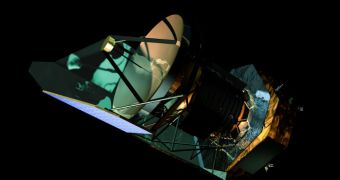The Herschel Space Observatory is the largest instrument of its kind ever launched in the Earth's orbit. Designed to provide astronomers and astrophysicists with deep insight into the origins of the Universe, and also into some of the most concealed and cold objects in the skies, the telescope was launched together with another groundbreaking companion, Planck. However, upon reaching its destination, the L2 Lagrangian orbital point, the massive observatory started experiencing a number of glitches. They have now been resolved, and the instrument is set to resume its observations, the BBC News reports.
Launched on May 14, 2009 from the French Guyana, the observatory experienced its glitches just three months later. The Heterodyne Instrument for the Far Infrared (HIFI) detector, built by a Dutch-led consortium, failed to record any data, and some believed that it had been lost. This would have been terrible news, as this instrument is one of only three major detectors on Herschel, alongside the Spectral and Photometric Imaging Receiver (SPIRE) and the Photodetecting Array Camera and Spectrometer (PACS). But, just a few days ago, researchers investigating the issue announced that they managed to fix the problem, by successfully starting up HIFI's back-up systems.
“We've had 30 people working on this. I don't watch much television, but I know Crime Scene Investigation and this was just such an investigation – but in space! We found out what happened and then we designed all the mitigating measures,” SRON Netherlands Institute for Space Research expert Dr. Frank Helmich explained during an interview for the British news agency. Helmich is also the lead scientist of the HIFI detector, which is in fact a spectrometer that can function in two different sets of wavelengths – 157 to 212 and 240 to 625 micrometers.
The most likely cause of the glitches, the SRON team believes, is a cosmic ray hitting one or more of the microprocessors in the instrument. This would help explain all of the telemetry data that the team collected from HIFI. Finding out the answer to what really happened “turned out to be a very complex technological puzzle that we had to solve based on limited information and under a great deal of pressure. But for all researchers involved, quickly finding an answer to this question was a matter of professional pride. We had to – and would – crack the problem with HIFI as soon as humanly possible, but we also had to take the time to be thorough,” Dr. Peter Roelfsema, who is the HIFI project leader, added.

 14 DAY TRIAL //
14 DAY TRIAL //